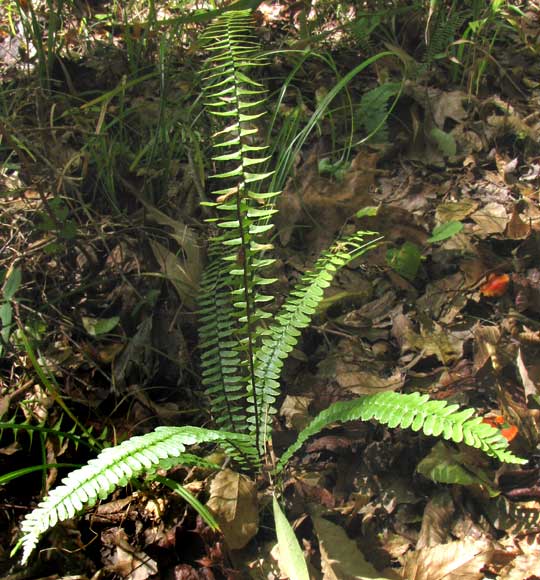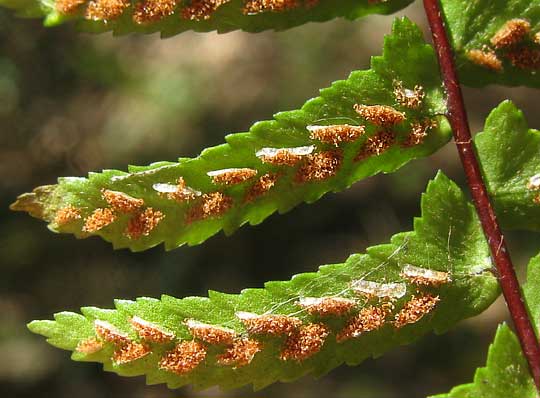Excerpts from Jim Conrad's
Naturalist Newsletter

from the November 1, 2009 Newsletter, from near Natchez, Mississippi
EBONY SPLEENWORTS
Christmas Ferns are the most abundant fern here. Our second-most common fern species is either the Southern Shield-Fern, which we've already taken a look at, at https://www.backyardnature.net/n/h/shield-f.htm or the Ebony Spleenwort, ASPLENIUM PLATYNEURON, shown above.
This is a much smaller, more delicate fern than the first two, and you recognize it at a glance by its slender, pagodalike fronds, and stiff, dark brown frond stems or rachises. You can see the fern's sori below:

The cinnamon-colored, granular masses there are bunches of spore-producing, baglike sporangia. Upon maturation the sporangia burst open and release spores. The pale, cellophane-like structures running alongside the sori are indusia, which protect the sporangia before they mature. Indusium presence and shape are important fern identification features.
Where I grew up in rural western Kentucky, similar to here in southwestern Mississippi, the Christmas Fern was the most common fern species. We were too far north for the Southern Shield-Fern, but the Ebony Spleenwort, as here, was the second-most common fern. This hints at the fact that this small, fragile- looking fern is tougher than it looks. In fact, it's recognized as an ecological generalist specializing in disturbed woods, but it also grows on rock and masonry, even in urban zones. With global warming, Ebony Spleenworts have been documented as migrating northward at the northern part of its range in the upper Great Lake states
The species occurs throughout nearly all the Eastern Forest Biome from Quebec southward, plus, amazingly, some quirk of history has made it native to South Africa as well -- a distribution shared by no other fern.
from the December 21, 2003 Newsletter, from near Natchez, Mississippi
EBONY SPLEENWORTS
An Ebony Spleenwort in a long-abandoned field up in Kentucky was the first fern I ever identified. That's because Ebony Spleenworts are distinctive and thus easy to identify. Their most striking feature, as the above pictures show, is their dark mahogany, almost black "midribs," or rachises, which very few other fern species have. All the other ferns I can think of with dark rachises are themselves other spleenwort species. About 720 known spleenwort species occur worldwide, though in the Natchez area the Ebony Spleenwort is the only common one. A couple of other spleenwort species could conceivably show up.
In our woods Ebony Spleenworts occur mainly where soil breaks through the leaf litter, as at bayou edges and on steep stream banks. They also grow in profusion on the moist, shaded, northern side of the barn here, right up against the foundation. When my mother was alive, Ebony Spleenworts grew on the northern side of her brick house, right against the foundation, well shaded by shrubby junipers. You might check the same habitat of your own home, and if you find a foot-tall, blackish-rachised fern, it'll almost undoubtedly be an Ebony Spleenwort.
"Spleenwort" is another nice botanical word worth paying attention to. The "spleen" part is fairly straightforward, because in ancient times the plant was used medicinally for the benefit of the spleen. This belief probably arose from the fact that the leaflets, or pinnae, of the common European spleenwort were shaped a little like a spleen, so the Doctrine of Signatures connected the fern with that organ.
"Wort" is a suffix found in many plant names, such as liverwort, moneywort, pennywort, navelwort, mugwort and ragwort. "Wort" derives from the Old English "wyrt," which simply meant "plant." The word goes back even further, to the common ancestor of English and German, to the Germanic "wurtiz." By the way, "wurtiz" evolved into the modern German word "Wurzel," meaning "root."